These Chinese Steamed Buns are pockets of steamy goodness, just waiting for you to fill them with tender meats, pickled vegetables, fresh herbs, and ooey-gooey sauces.

Why This Chinese Steamed Bun Recipe Is So Good
- Simple dough that can be used for many different Chinese steamed buns
- Easy to follow recipe
- Buns that are won’t split apart too soon
- Smooth, white and perfectly puffy
Ingredients
- Warm water
- Instant yeast
- Cooking oil
- Sugar
- All purpose flour
- Salt
- Baking powder
- Parchment paper
How to make Chinese Steamed Bun Recipe – Step By Step
The first step is to make the dough, mixing in warm water, yeast, sugar and cooking oil. Then flour, baking powder, salt. In the photo below, the dough was sticking to the side of the bowl, we added another tablespoon of flour.

Let your mixer do the work for you, mixing with the paddle first, then switching to the dough hook to knead — or turn out on your counter to knead by hand, which is what my Mom prefers to do.

Knead until you get a smooth, supple dough.

You can return this dough back in the same mixer bowl. Cover with plastic wrap or a towel and let it rise in a warm spot for 1-2 hours, until it just about doubles in size.

After the rise, gently turn out the dough back on your counter that you’ve lightly dusted with flour. Divide the dough into half, roll out each half into a long log. Cover one log with plastic wrap so that it doesn’t dry out. Further divide the log into 6-7 pieces, depending on how big you want your buns.

Take one piece of dough into your hand.

Fold the edge of the dough into the center and press down. Do this all the way around. This motion creates a smooth ball and increases the surface tension to help shape the ball.

See how all the edges of the dough have come into the center? Pinch that center to keep all the edges together.

Turn the ball over. Now you should have a perfectly smooth, round piece that is nice and taut with surface tension.
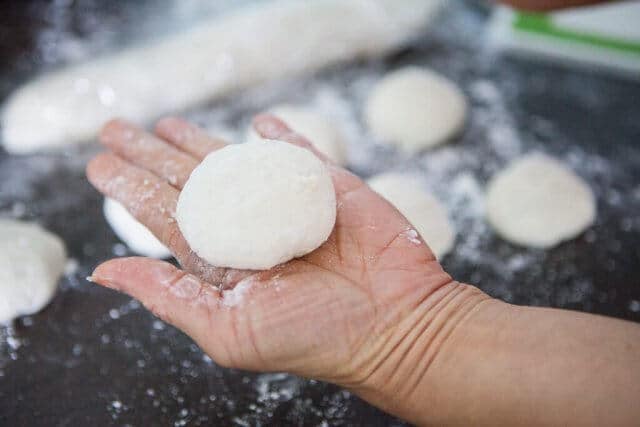
Use your palm to flatten that ball out.
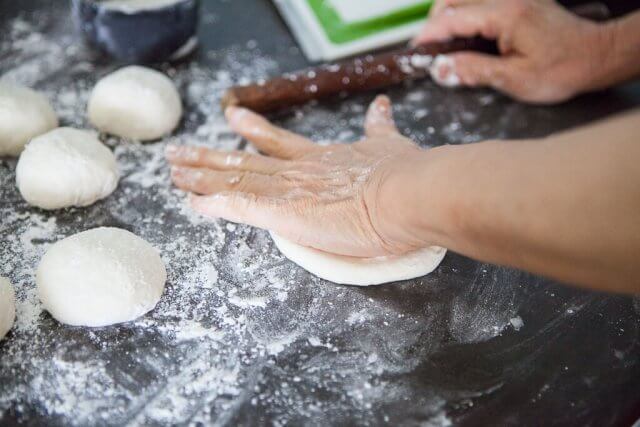
Use a rolling pin to roll back and forth to create an oval.

Like this:
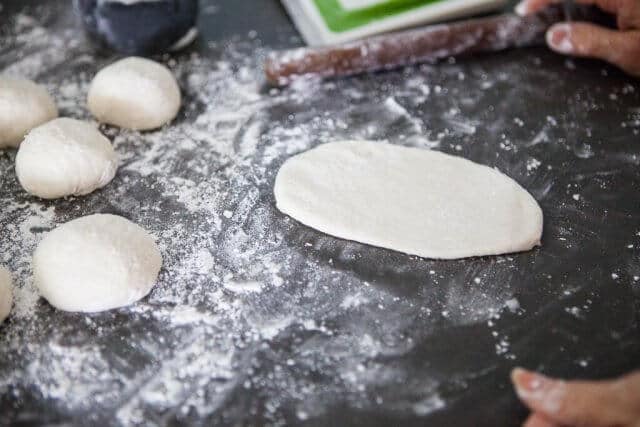
Brush the surface with cooking oil.

Fold over one edge.
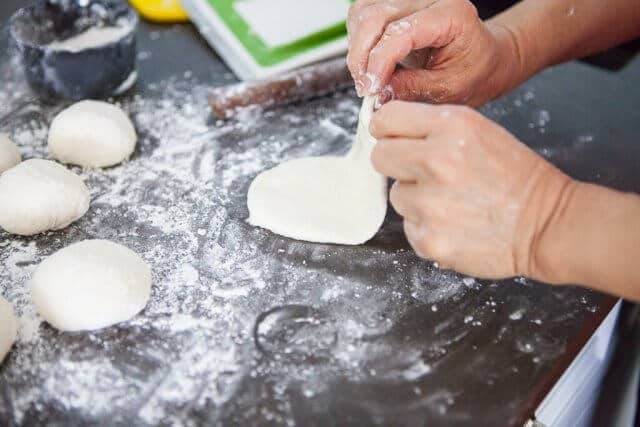
To create the bun. The cooking oil helps keep that seam, so that when you are ready to eat, you can open the bun. Without the cooking oil, the dough would stick together and be difficult to open the bun.
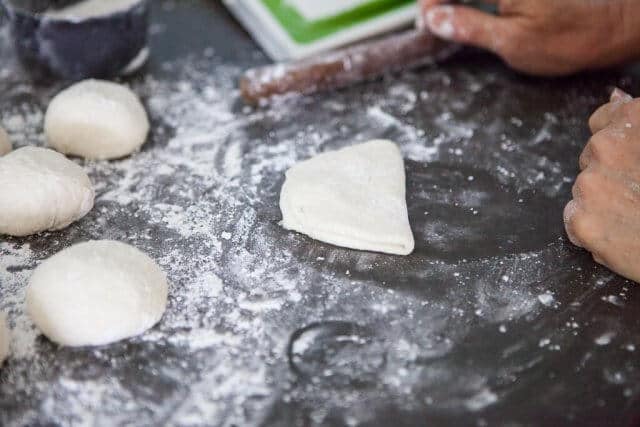
However, if you steam the bun after this step, the bun will open up in the steamer. That’s not what you want. You want the bun to stay closed during cooking.
So, what you need to do is roll one more time on top, not too hard, just a little bit of pressure is all that’s needed.

Place bun on a small square of parchment paper.

Fill your steamer, but give the buns enough room to expand during cooking without touching. We use 10″ bamboo steamer at our house (I suggest no smaller than 10″). My Mom loves her multi purpose, stainless steel double boiler/steamer set.

I used to just set my bamboo steamer directly into my wok, but it would sit so low that I would constantly run out of water during steaming. This is a big problem – when you run out of water during steaming, the food will begin to taste burnt and metallic. No water in the wok means no steam…instead, smoke.
I began using Helen Chen’s Steaming Ring set on top of any of my large pots. The Steaming Ring is $9.99 and allows you to transform any of your stockpots or dutch ovens to work with a bamboo steamer. It’s definitely worth every penny!

Place the ring on top of the pan. Fill pan with about an inch of water.
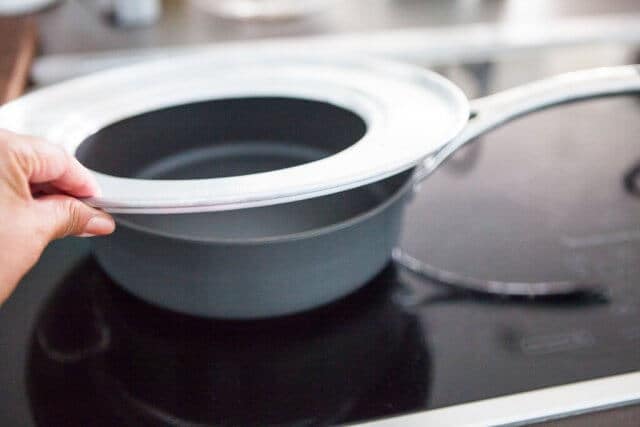
Set your bamboo steamer on top. It works perfectly with a 10″ bamboo steamer.

Next steps:
1. Do not turn on the heat yet. Let the buns rest and rise for 10 minutes, just as-is.
2. After 10 minutes, turn on the heat to high.
3. When you begin seeing steam rise from the top of the bamboo steamer, reduce heat to medium-high and set your timer for 5 minutes.
4. After 5 minutes, turn off heat. Do not open steamer – let the buns rest for 1 minute.


Delicious Steamed Buns From Scratch
Chinese Roast Duck certainly begs for handmade, freshly steamed buns. I’ve shared before our little shortcut secret using store-bought sourdough biscuit dough sold in cans, or a pre-mixed flour found in Asian supermarkets. This time, Mom and I made them from scratch, experimenting with a couple of different recipes and declaring this recipe the winner.


Light And Fluffy Chinese Steamed Buns
Here’s the secret to white, puffy buns that don’t collapse or fall:
I’ve made these buns so many times, and each time, the buns would turn out beautiful and perfect, but then would deflate or flatten after cooling. They also would take on a little yellowish tinge and be a bit chewy.
The secret that I’ve learned from my Mom:
The bamboo steamer needs to be in place before the heat is turned on. This allows the buns to heat up and steam gently and slowly, as the water begins to boil. My old method was to wait for the water to boil before placing the bamboo steamer, which caused the buns to cook too quickly, which resulted in a chewier bun.
Remember, steamed buns should be delicate and light — and so the cooking method needs to be gentle as well.
Turning off the heat (step 4 above) but NOT opening the steamer for 1 minute allows the buns to gradually come down in temperature and also lets the buns sit in gentle steam to finish the cooking process. This helps prevent collapsing buns — and keeps the buns nice and white.
Take a look at this bun – nice and fluffy. The seam is distinct and easy to open, but stays closed during cooking, which is what you want.

Chinese Steamed Buns And Roast Duck
I hope you have a chance to make these Chinese Steamed Buns, the next time you get a Chinese Roasted Duck on your hands (maybe you are lucky enough to have Mom who will bring you one?) Or you can make your own Chinese Roasted Duck – here’s my easy recipe.
To Accompany the Chinese Roast Duck
- Julienned cucumber
- Thin slivers of green onion (I soak in ice cold water to get them super crispy/crunchy and curly.
- Hoisin sauce (store-bought)
Top Tips For Chinese Steamed Buns
- When mixing your dough in the bowl, if it is sticking too much then add a touch more flour
- Make sure to dust your counter with some flour when turning out the dough.
- The bamboo steamer needs to be in place before the heat is turned on. This allows the buns to heat up and steam gently and slowly, as the water begins to boil.
- Serve with roast duck!

Equipment
Check Out These Other Delicious Recipes
- Chinese Roasted Duck Recipe (with pre-mixed Asian dough for steamed buns)
- Chinese Pork Belly with Steamed Buns (with cheater buns recipe from store-bought sourdough biscuit dough in can)
- Sous Vide Pork Belly Recipe (WOW – we love this recipe!)
Have you tried this Chinese Steamed Bun recipe? Feel free to leave a star rating and I’d love to hear from you in the comments below!

Chinese Steamed Buns Recipe
Ingredients
- 1 cup warm water
- 1 1/2 teaspoons instant yeast
- 1 tablespoon cooking oil canola or vegetable, plus more for brushing
- 3 tablespoons sugar
- 3 cups all-purpose flour + more for dusting
- 1/4 teaspoon salt
- 1/2 teaspoon baking powder
- 14 squares parchment paper 4"x4"
Instructions
- In a mixer bowl, add the warm water, oil, yeast and sugar. Let sit for 1 minute, until the yeast begins to bubble a bit. Next, add in the flour, baking powder and salt, in that order. With the paddle attachment, mix on low for 2 minutes. Add more flour, a tablespoon at a time, if the dough sticks to the sides of the bowl. Change to a dough hook, and on speed 2, knead for 4 minutes, until dough is smooth, supple and clear the sides of the bowl. If the dough sticks to the side of the bowl, add more flour, a tablespoon at a time.
- Dust your counter with a little flour and turn out your dough. I like to hand knead it a few times, so that I can get a feel for the dough. Shape the dough into a smooth ball. Return the dough ball to the mixing bowl, cover with a clean towel and let rise in a warm, dry spot for 1-2 hours, until it nearly doubles in size.
- Turn out your dough onto a lightly floured surface. Cut the dough in half. Gently roll each half into a log shape. Cut each log into 6 or 7 little balls. We'll work with one ball at a time, so keep the rest covered with plastic wrap so that they don't dry out. Form each ball by bringing in the sides (see photos above) and pinching the center. Turn ball over to get a nice, taut ball. Roll the dough ball out to a long, oval shape about 6"x3". Brush the top with a little cooking oil. Fold over one side of the oval. Use your rolling pin to gently roll and press one last time. Place bun on a parchment paper square, place into the bamboo steamer and cover with lid to prevent drying. Repeat with the remaining dough balls.
- Fill your pot or wok with 2" of water. Place the steamer ring (if you have one) bamboo baskets on top. Do not turn on the heat yet. Let rest for 10 minutes. Then, turn on the heat to high. When you begin to see steam coming up from the top of the steamer, reduce heat to medium-high. Let steam for 5 minutes. Turn off the heat, without opening the steamer. Let rest for 1 minute. Open steamer and gently lift the steamer baskets off one another to let the buns cool.





Thanks for sharing
I think it would be a GREAT idea for one of your giveaways , if you had one for one of the steaming rings and a bamboo steamer!! (Just a thought)
Have a great day.
These buns turned out amazing! I have the three tiered plastic steamers. The top layer required another 5 min to cook. Other than that, my kids said it’s better than the ones at the restaurant. Thank you for the post!
Thank you so much Joan! – jaden
Made this tonight with the pork belly ABSOLUTELY AMAZING, and the directions and hints helped so much and it turned out perfectly
I made the cheat buns so easy..
Yummy
Thank you Jodi! -jaden
Awesome recipe. Thanks! I appreciate the detail on process because bread is all about process. I made this with a simple pickle inspired by yours and some galbi. My kids loved these because they have no crust!
Thanks so much Josh! -jaden
Thank you for this great recipe and instructions. My boys are happy tonight! I filled mine with Peking Duck. They did come out quite large so I’d make them smaller next time. But we’re happy and full.
Thanks Annalusa! -jaden
The buns came out beautifully! I filled them with tonkatsu chicken, pickled shredded cabbage, sriracha mayo, sliced cucumber, sliced jalapeño, shredded carrot and coriander. My kids were over the moon!
Thank your mom, Jaden!
Thanks so much Gale! -jaden
Does the Helen Chen adapter ring have a groove on the bottom and top to prevent slippage? I have a clone, and it is smooth, so I’ve lost an entire steamed flan and am looking for a better adapter.
Hi Danilo- I don’t recall! The ring is somewhere in my kitchen, hidden LOL. We moved last year and now I can’t find a single thing!
Thanks! Made them last night! They got swiped clean! Will be making them more often!
Hi,
Is this recipe the same as the mantou buns?
I’m making your buns all the way in India, but I really want to make the pork filled Chinese buns! Do let me know!
Yes they are! Mantou is shaped differently, but same dough.
I recently made a Blue Apron recipe with these Chinese steamed buns, and loved it. I want to make the steamed buns myself, and thank you for such a great tutorial. Because of you, years ago, I bought a wok, with a lid, and a bamboo steamer. I use it all the time, and have made several of our recipes. I’m excited to try these out!
Can you tell me if these will keep after steaming for any duration of time? If so, should they be refrigerated? How to reheat? Thank you so much!
The buns refrigerate nicely. You can re-steam them to just heat through, right before serving. You can also put the buns on a plate, cover with a damp towel or damp paper towel and microwave for 30 seconds.
Hello! Thank you for sharing this recipe! I finally tried to make these buns and they are outrageous yummy! Next time I will fill them, this time I made them plain. Tasty, fluffy and we just feel like we could eat them all! I’ll try to freeze them now ’cause I made a whole bunch (and I already ate 4) just for me and my man. Thank you once again, your recipe is a keeper 🙂
Thanks so much! Happy you love them 🙂
Jaden, hi!
Thanks so much for the recipe! I made it today and was really really satisfied with the result!! Buns didnt collapse and stayes super white! And were super fluffy! Thanks a lot!
Thank you so much!
I am looking for a rice flour bun – can I use rice flour with this recipe, maybe 1:1 with AP flour?
Hi Courtney – Not sure that rice flour will work in this recipe.
Hi. Thanks for this wonderful recipe. I’ve been meaning to make it for a while now and finally will give it a try tomorrow!! Now…last minute question…I hope to get an answer on time pleaseee 😉 I don’t have a machine to mix the dough. Will it work out fine if I mix it by hand? Thanks a thousand times!
Yes absolutely! I use just a wooden spoon. Mom uses chopsticks 🙂
These buns are great! I’ve made them several times, but they always stick to the parchment paper. I don’t see that anyone else seems to have this problem, so I’m not sure what I am doing wrong. Doesn’t effect the flavor those and a batch of these are finished in minutes in my house!
Hi! Mine stuck to the paper too, but no complaints at all! they were amazing. My questions is how to best keep the leftovers???
Thank you for sharing this excellent recipe. I tried it with marinaded duck breast and also crispy Pork belly. I was just wondering if I made a huge batch of dough, rolled them into shape and kept them in the fridge ready to steam later, if they would rise enough. I’m doing around 60 for a friends wedding and I’m thinking of implementing this process. I’m going to use a bain Marie to steam them. I would love to know your thoughts on this. Thank you very much. Steffan (Wales-United Kingdom)
Hi Steffan, As long as you remove them the dough from the refrigerator in time so that they can come to room temperature, you should be fine.
Thanks very much for this blog and thanks also for answering this question, which was identical to mine. How to make plenty in advance for a spacial event.
Hello Steffan, did they work? 🙂
I want to thank you for the detail explaination on steaming the Pau. I’ve searched high and low… Luckily I found you.
Hi, I made these buns from your recipe and they were delicious. I don’t think they stock white lily flour in Australia so mine did turn out a bit beige/yellowy? My sister gave me a 9/10 when I made her my Karaage Chicken steamed buns 🙂
We just cooked these and they worked perfectly! Thank you for sharing.
My steamer basket is a bit smaller than yours. Can I cook them in batches? If so, how should I keep them warm between batches?
Hi Christine- yes you can steam in batches. It’s hard to keep them warm without drying out. What I’d recommend is steam them in batches to cook. When ready to eat, reheat them in the basket with the steam for just a minute or two. Sometimes, I’ll steam the next batch while we eat, so there’s aways a hot bun ready to serve. Another way to reheat is to put the buns on a plate, cover all the buns with a damp towel (or paper towel). Microwave for 30 seconds at 75% power. The damp towel keeps the buns moist – and they won’t dry out.
I adore steamed buns. Until now I have only ever made them with pork (and once with lamb) but never with duck. What a heavenly combination!
“Mom also used a cooler in her carry on to bring fresh roasted duck and crispy roasted pork from a famous restaurant near her home. That’s the dedication of a loving Mom and true food lover!”
You forgot to add “Chinese” in there! My mom does the exact same thing!! Love the food goodies!
How did she bring it across the border without any trouble? Please let me know so I can ask my relatives to bring me some next time!
You are so funny and full of life. I laugh at all your jokes. ..I So get you! I visit your sites sometimes when I need someone to cheer me up after a long day with my boys. .love ur food!
Thank you so much Belinda!
Hi, Jaden.
Your Chinese Steamed Buns look so yummy! Thanks for sharing the recipe. I’ve tried this type of steamed buns at a Chinese shop in Melbourne and they tasted great. Sadly, the buns were really tiny and very expensive! So I decided I’ll make my own steamed buns from scratch next time. I’ll definitely give your recipe a go soon.
I’ve just started a food blog for my Uni project. My website is:
http://www.delishspecials.wordpress.com
It’ll be great if you could drop by and support my project. 🙂 Thanks for being a great cooking inspiration to me!
Thanks so much Jaden. I love lap cheong very much and could not find anything similar to what I used to have back home.
hello Jaden!
Whether I am using bamboo or metal steamer, I always put a clean dish towel over the top of the steamer before putting the lid on. Works everytime in catching those droplets of water which may have formed ESP. With metal steamer so they don’t fall on the buns!….not so much when using bamboo steamers.
Am in Canada so will look for Happy meat chinese sausage. Have always used Wing Wing brand.
That’s a great tip! Thanks Betty! Jaden
I’ve had these absolutely addictive steamed buns in restaurants, but it never OCCURRED to me that I could make them myself! And now with this post, of course I can! I even have a bag of White Lily flour…it’s a sign! 🙂
My late father from Taiwan and is Northern Chinese with Chinese Muslin in him. Mom learn to steam mantao for him and other type of breads to eat.
She Cantonese but learn a lot from his family.
Hi Jaden,
The “SECRET TIPS THAT MAKE A BIG DIFFERENCE” section really helps. I have made Char Siu Pao before and I believe the process is quite similar. Just one question: What is the most appropriate type of flour I should use to make the bun?
We use White Lily flour, a brand that is popular here in the South. It is a more tender flour than most all-purpose. This is measured by protein content. The higher the protein content, the more gluten forms – so high protein (bread flour) is good for baguettes, crusty, chewy breads. Steamed breads and pastries are more delicate, so lower protein is best (all-purpose flours). But not all brands are alike. Here is a handy chart to tell you protein content.
Thank you so much for taking your time to explain in detail. The chart to show the protein content of each type of flour is really useful. I have just shared it on facebook.
Where did your mom purchase the roast duck and roast pork that she brought? I’m assuming that they live in Las Vegas.
Hi Sandy – They live just outside of Vegas. I’ll have to ask them where they bought the duck and pork!
Ooh, finally something I can buy locally!
Although I do prefer American duck because it’s much, much leaner than Canadian duck, at least those available here for Peking-style duck. Canadian duck just oozes fat between the skin and meat layers.
Thanks Jaden!
as with anything there are different birds for different uses. Pekin (no g) ducks are what you want for this recipe. Although Barbary or Moulard ducks are better for magret (duck breast steak basically)
try this recipe
http://beaus.ca/lug-tread-marmite-seared-breast-duck-green-peppercorn-sauce/
Your bun and roast duck looks delicious. Thanks for sharing the recipe. Where could I get the Happy Meat brand lap cheong in the US?
Thanks
Hi Quynh – Happy Meat is only sold in Canada.